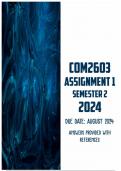, PLEASE USE THIS DOCUMENT AS A GUIDE TO ANSWER YOUR ASSIGNMENT
Please note that the author of this document will not responsibility for any plagiarizing you
commit.
You need to introduce the entire assignment by briefly introducing all three sections discussed in
the assignment.
Introduction
In today's interconnected world, effective communication is paramount across various domains. This
assignment delves into three crucial areas: intercultural communication, development
communication, and health communication. Each section highlights the importance of understanding
and employing strategic communication techniques to foster better interactions, drive development
initiatives, and promote health and well-being within communities.
SECTION 1: Intercultural Communication
Intercultural communication involves the exchange of information between individuals from
different cultural backgrounds. It emphasizes the importance of understanding cultural diversity,
overcoming language barriers, and fostering mutual respect to facilitate effective communication.
This section explores strategies to navigate cultural differences and enhance intercultural interactions
in diverse settings.
SECTION 2: Development Communication
Development communication focuses on using communication to promote social development. It
involves disseminating information and encouraging participation to address social, economic, and
environmental issues. This section discusses the role of communication in driving developmental
change, engaging communities, and implementing successful development programs.
SECTION 3: Health Communication
Health communication aims to improve public health outcomes by effectively disseminating health
information and encouraging healthy behaviors. This section utilizes the Diffusion of Innovation
Theory and the exchange approach theoretical framework to illustrate how a new exercise app can be
promoted within a community. By understanding the stages of innovation diffusion and leveraging
incentives for engagement, health communication strategies can effectively address mental health
challenges and promote healthy living.
Understanding and applying principles from intercultural, development, and health communication is
essential for creating meaningful and impactful interactions. By embracing cultural diversity,
promoting development initiatives, and addressing health concerns through strategic communication,
we can enhance the quality of life and foster positive change in communities. This assignment
underscores the significance of tailored communication approaches in achieving these goals.
, Section 1 - Intercultural Communication
Question 1
1. Explain the concept of ‘global village’ and discuss the role of technology in facilitating human
communication.
The concept of the "global village" was introduced by Marshall McLuhan in the 1960s. McLuhan
envisioned a world in which the proliferation of communication technologies effectively shrinks
geographical and cultural distances, creating a metaphorical village where people are interconnected
regardless of physical proximity. In this global village, information and experiences can be shared
instantaneously across vast distances, fostering a sense of global community.
The role of technology in this concept is pivotal. Advances in communication technology, such as
the internet, mobile phones, and satellite communication, have enabled people to connect and
interact in real-time, regardless of their location. The internet, in particular, has revolutionized access
to information and communication. It provides a platform for sharing ideas, cultures, and knowledge,
thereby fostering understanding and cooperation among people from different parts of the world.
Social media platforms and instant messaging services have further enhanced this interconnectedness,
allowing individuals to maintain relationships and engage in cultural exchange without the need for
physical presence.
Technology has democratized access to information. The World Wide Web offers a vast repository
of knowledge and data, enabling individuals to stay informed about global events and developments.
This accessibility helps break down cultural barriers and promotes a more inclusive global discourse.
For instance, online education and e-learning platforms have made it possible for people in remote
areas to access quality education and training, contributing to the reduction of global inequalities.
However, the impact of technology on communication is not without its challenges. While it
facilitates connection, it can also lead to superficial interactions that lack the depth and nuance of
face-to-face communication. The absence of non-verbal cues, such as body language and facial
expressions, can sometimes result in misunderstandings and miscommunications. Additionally, the
digital divide—wherein certain populations lack access to modern communication
technologies—can exacerbate existing inequalities and marginalize those without the means or
knowledge to participate in the digital world.
Despite these challenges, the overall impact of technology on human communication has been
profoundly transformative. It has enabled the creation of virtual communities and networks that
transcend geographical boundaries, fostering a sense of global citizenship and collective identity. For
example, diasporic communities use online platforms to maintain cultural ties and support networks,
reinforcing their sense of identity and belonging.
In conclusion, the concept of the global village underscores the transformative power of
communication technology in uniting people across the globe. While it presents certain challenges,
the role of technology in facilitating human communication has been largely beneficial, promoting
global awareness, cultural exchange, and inclusivity. As technology continues to evolve, it will likely
further enhance our ability to connect and communicate, reinforcing the interconnectedness of our
global village.
(Study Guide - Page 4)




